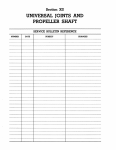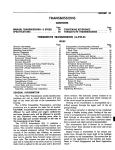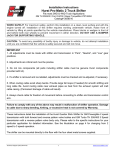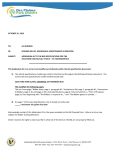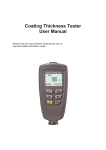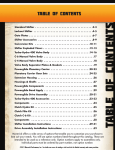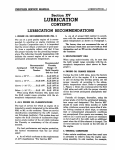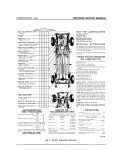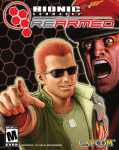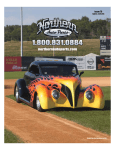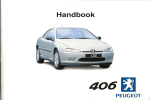Download UNIVERSAL JOINTS AND PROPELLER SHAFT
Transcript
UNIVERSAL JOINTS & PROPELLER SHAFT—1 CHRYSLER SERVICE MANUAL Section XII UNIVERSAL JOINTS AND PROPELLER SHAFT CONTENTS Page Servicing Cross Type Universal owuut 4 Servicing Ball and Trunnion Type Universal Joints 4 Servicing Cross and Yoke Type Propeller Shaft 6 Servicing Propeller Shaft Center Bearing 7 Rear Axle Control Strut. 7 Checking Propeller Shaft Angles 11 Service Diagnosis 11 DATA AND SPECIFICATIONS Models Town 8s Country LC-1 LC-3 LY-1 LC-1, 2 LC-3 1 1 1 1 2 3.0 in. 3.0 in. 3.25 in. 3.25 in. 2.75 in. 3.25 in. 3.25 in. 3.25 in. 3.25 in. 2.75 in. 58.96 58.96 58.96 58.96 63.64 Propeller Shaft Number Used Diameter With TorqueFlite Transmission Diameter with Air Conditioning And TorqueFlite Transmission Length Centerline to Centerline of "U" Joints With TorqueFlite Transmission 2—UNIVERSAL JOINTS & PROPELLER SHAFT CHRYSLER SERVICE MANUAL ROLLER A N D BUSHING ASSEMBLY ROLLER AND BUSHING ASSEMBLY RETAINER PROPELLER SHAFT BUSHING RETAINER CLAMP RETAINER CLAMP LOCKWASHER ROLLER DUST SEAL BOLT DUST SEAL RETAINER ROLLER A N D BUSHING ASSEMBLY CROSS ASSEMBLY ROLLER DUST SEAL BUSHING RETAINER DUST SEAL RETAINER ROLLER AND BUSHING ASSEMBLY 55x767 A Fig. 1— Rear Universal Joint—Cross Type (Disassembled View) CENTERING BUTTON BUTTON SPRING BALL A N D ROLLERS GREASE COVER v GASKET PIN NUT THRUST WASHER BODY PROPELLER SHAFT BALL A N D ROLLERS LOCKWASHER SHAFT BOLT BUTTON SPRING CENTERING BUTTON 54x49 Fig. 2—Front Universal Joint—Ball and Trunnion Type (Disassembled View) CHRYSLER SERVICE MANUAL UNIVERSAL JOINTS & PROPELLER SHAFT—3 DATA AND SPECIFICATIONS (Cont'd) Models Flange to Flange Length With TorqueFlite Transmission LC-1,2 LC,3 Town & Country LC-1 LC-3 LY-1 61.10 61.10 61.10 61.10 64.14 Lubrication •PRE-PACK Universal Joints Type (Front) Ball and Trunnion (Rear) Cross Type Cross Type (Only) ANTI-FRICTION Bushing-Bearing Type •Every 20,000 miles. Section XII UNIVERSAL JOINTS AND PROPELLER SHAFT UNIVERSAL JOINTS Two types of Universal Joints are used on 1958 Chrysler Models and are as follows: The Cross Type, as shown in Figure 1, and Ball and Trunnion Type, as shown in Figure 2. The ball head of the Ball and Trunnion Type, is an integral part of the tubular propeller shaft and is covered by the joint body. The pin, with balls, needle bearings, thrust washers, centering button, and button spring at each end, extends through the propeller shaft ball head and rides in ball channels in the body of the joint assembly. This balanced installation is designed to absorb thrust and torque of the drive line. This type of joint is used in Chrysler Models LC-1, 2 and 3 at front universal joint. The Cross Type universal joint is used at rear joint of all models, and front and center bearing joints of Imperial Models which are equipped with center bearing and two propeller shafts. No adjustments are provided to compensate for wear in universal joint assembly. Parts that show excessive wear must be replaced. CAUTION When disassembling universal joints, keep parts identified as to original position. Failure to assemble parts in their original positions may cause an unbalanced condition in the propeller shaft. Retorque mounting nuts after the initial 1,000 miles of operation. 4—UNIVERSAL JOINTS & PROPELLER SHAFT CHRYSLER SERVICE MANUAL CROSS TYPE 1. SERVICING CROSS TYPE UNIVERSAL JOINTS (Fig. 1) Remove propeller shaft from the vehicle. Remove two bushing retainers holding bushings in shaft yoke and remove bushings. Tilt cross so that it may be removed from propeller shaft yoke. Straighten out end of retainer lock and remove two roller and block assemblies. Remove dust seals and retainers. Inspect parts and replace parts that show wear. Lubricate roller and bushings with universal joint grease (extreme pressure) and assemble joint in reverse order of disassembly. BALL AND TRUNNION TYPE 2. SERVICING BALL AND TRUNNION TYPE UNIVERSAL JOINT To disassemble universal joint for repair or inspection of all component parts, refer to Fig. 2 and proceed as follows: Remove joint body metal cover and gasket by bending tabs of cover away from body; remove cover and gasket. Slide body down on propeller shaft exposing two centering buttons. Remove centering buttons and spring washers from ends of trunnion pins. Slide two balls, rollers, and thrust washers off trunnion pin. Wash all parts with solvent and blow dry with compressed air. Inspect and replace worn parts. NOTE: Reconditioning of ball and trunnion type universal joints will only be necessary when excessive backlash exists between balls and trunnion. In some instances, it will be found that universal joint body has worn, and it will be necessary to replace all parts, including body pin, thrust washers, and centering buttons. Worn rollers should also be replaced. CAUTION When installing trunnion pin in propeller shaft care should be taken to see that trunnion pin is centered in shaft. Each end of pin should protrude the same distance, with variation of no more than .003 inch. If one side of pin extends more than .003 inch farther than the other, propeller shaft will be out of balance. Tool C-3534 (LC-1 and 2 models), Tool C-3211 on the LC-3, as shown in Figure 3, will facilitate removal, installation, and centering of trunnion pin. Failure to observe these recommendations may result in an out-of-balance condition causing vibration. 3. UNIVERSAL JOINT MAINTENANCE (BALL AND TRUNNION) The universal joints, propeller shaft, and hand brake drum are accurately balanced during process of manufacture. Care should be exercised to maintain this condition of balance by close adherence to the following: Do not use more than 2% ounces of lubricant in a universal joint (ball and trunnion type) of the LC-3 and 2 ounces in the LC-1 and 2 at any time. Keep propeller shaft, hand brake drum, flanges, etc. free from undercoating, dirt and ice. Fig. 3-lnstalling Joint Pin CHRYSLER SERVICE MANUAL UNIVERSAL JOINTS & PROPELLER SHAFT—5 4. SERVICING EXTERNAL TYPE UNIVERSAL JOINT DUST COVER UNIVERSAL JOINT CENTERING PIN PROPELLER SHAFT UNIVERSAL JOINT DUST COVER OR BOOT UNIVERSAL JOINT BODY To replace an external type universal joint dust cover (Fig. 4) that is damaged, remove propeller shaft assembly from car and clamp lightly in vise. One end of shaft should be resting on bench in a horizontal position, disassemble joint, removing all parts except body and pin. Clean body, ball head, and pin, thoroughly. A complete coating of grease (or suitable rubber lubricant) must be smeared on outside and inside of dust cover, entire surface of ball head, pin, and inside of body. (It is very important that this instruction be followed.) Stretch grease-soaked boot or dust cover over pin and ball head, as shown in Figure 5. Work dust cover into body as far as possible. CAUTION USE NO TOOLS FOR THIS OPERATION. With body in. position so pin can enter ball channels, pull body sharply over pin, thereby forcing dust cover into body. With one hand, grip end of dust cover, protruding through back end of body. With other hand, pump body back and forth, as shown in Figure 6, until entire dust cover has passed through body. During operation cone may have reversed itself inside dust cover. Pull it out to its normal position. Insert 2y2 ounces of heavy fiber, universal joint grease in joint of LC-3 (2 ounces in the 49x910 Fig. 5-Sliding Cover Over Ball Head and Fin LC-1 and 2) and assemble balls to pin. Install cover. Install shaft, using new lockwashers. Be sure to double check flange bolts for tightness, to insure against grease leakage. Recheck after 1,000 miles of operation. CAUTION Never attempt to use a needle-like arrangement for forcing lubricant into boot (or dust cover) on universal joints. Excessive grease can be forced into boot and cause shaft to be thrown but of balance, burst boot, or lubricant can be lost through injection hole during high speed operation. The joints must be disassembled and packed with universal joint grease. 55x766 Fig. 4—External Type Dust Cover Fig. 6 - W o r k i n g Dust Cover Through Body 6—UNIVERSAL JOINTS & PROPELLER SHAFT CHRYSLER SERVICE MANUAL CROSS AND YOKE TYPE PROPELLER SHAFT 5. SERVICING CROSS AND YOKE TYPE PROPELLER SHAFT (Fig. 7) (Imperial Models) a. Removal Remove nuts, lockwashers and bolts holding universal joint and propeller shaft to differential and transmission companion flanges and center bearing to frame crossmember. Remove propeller shaft assembly. b. Disassembly Place assembly in bench vise and remove splined yoke cross bushing retainers. Press out bushings and remove cross from yoke. Remove bearing blocks, dust seals, and dust seal retainers. Remove retainers from cross roller bearings. Press out bearings and cross. Remove dust seals and retainers from cross. The cross roller bearing block and its component parts, also form an assembly. These parts are not serviced separately. After disassembly, clean and inspect parts and replace those worn or damaged as necessary. c. Assembly Lubricate all parts before assembling. If splined joint at rear of front propeller shaft has been disassembled, fill cavity with one ounce (by weight) of MS 1124. The center bearing is a sealed bearing and does not require lubrication. Install dust shields and retainers on cross. Press cross roller bearing and bushing assembly into yoke with cross in proper location. CAUTION Make certain that all of roller bearings are correctly placed in roller bushing. Also, be sure balance arrows are in alignment (Fig. 7 ) . d. Installation Place propeller shaft in its correct position under car. Make certain that slip-spline end of shaft is located toward front of car. Insert attaching screws and tighten securely. BUSHING SEAL .RETAINER HOUSING BEARING SLINGER SHAFT SPACER Fig, 7—Propeller Shaft and Center Bearing Assembly (Disassembled View) 56x320 CHRYSLER SERVICE MANUAL UNIVERSAL JOINTS & PROPELLER SHAFT—7 6. SERVICING PROPELLER SHAFT CENTER BEARING (Figure 7) The center bearing and housing must be removed as a unit, together with front propeller shaft, for servicing. CAUTION Do not extend two piece center bearing pro- peller shaft to its full length. The seal may be damaged by the splines on universal joint yoke. With yoke all the way into front propeller shaft, bend up tang on dust seal cover. Remove cover, seal, lock and dust slinger and remove center bearing assembly. Inspect bearing, bracket, seal. Replace necessary parts and reassemble. REAR AXLE CONTROL STRUT The 1958 Imperials are designed with two propeller shafts and a propeller shaft center bearing, as shown in Fig. 8. Conditions may arise under certain passenger loads which may create a propeller shaft shudder or vibration at speeds of 15 to 20 miles per hour. With fuel tank approximately % full, determine under what speed and passenger load a shudder is present and if shudder is light, moderate or heavy. Check the indexing of universal joints and propeller shaft assembly, as shown in Figure 7. The letter "0" on front In order to control this shudder or vibration, a rear axle control strut, as shown in Figure 9, has been incorporated in rear axle design for purpose of controlling rise of nose of rear axle carrier under varying load conditions. Corrections of propeller shaft shudder should be made as follows: Before diagnosing a shudder condition, make sure engine has been tuned and is operating smoothly with no hesitation or stumble on accelerator. FRAME BRACKET I HOUSING BRACKET NOTE: A rough engine can aggravate or produce a shudder. FRONT PROPELLER SHAFT ASSEMBLY 57x311 Fig. 9—Rear Axle Control Strut SEAL NUT LOCK CENTER BEARING OIL SLINGER REAR PROPELLER SHAFT ASSEMBLY 56x242 Fig. 8—Center Bearing Installed Fig. 10—Differential Carrier Bumper Plate 8—UNIVERSAL JOINTS & PROPELLER SHAFT CHRYSLER SERVICE MANUAL 58x702 Fig. 11—Indexing Gauge Installed Fig. 13—Checking Propeller-Shaft Angle face of spline should be lined up with key slot at rear of front shaft. Place car on platform with weight of vehicle on rear wheels. With fuel tank between % and full and weight of vehicle on wheels, remove differential carrier rebound bumper plate, Figure 10. tion marks fore or aft, rear axle joint angle is within specifications and should be considered standard adjustment. Working from the left side of car, place and index the aligning gauge Tool J-6845 on the machine pads of the differential carrier, as shown in Figure 11. Adjust bubble of gauge to show zero or level position. With zero remaining in the level position, remove gauge from differential housing and install gauge along the underside of rear propeller shaft as shown in Figure 12. With gauge properly located under shaft (with level readable from the left side of shaft, Fig. 12), note the location of the leading edge of bubble in level gauge; if bubble is still at zero or level position or within three gradua- If leading edge of bubble is forward of the third graduation, the propeller shaft angle should be corrected by placing a 2 degree taper.ed shim between the rear axle housing pads and both rear springs with the thick end of shim towards the front of car. NOTE: To install shim the rear spring "U" bolts should be loosened just enough to allow for installation of tapered shim without misalignment of spring center bolt and housing pad. To allow the differential carrier to reposition itself or assume the new angularity after installation of tapered shims between housing pad and rear spring, the control strut frame 58x701 Fig. 12—Indexing Gauge Under Shaft Fig. 14—Gauge Adapter Installed CHRYSLER SERVICE MANUAL UNIVERSAL JOINTS & PROPELLER SHAFT—9 to bracket bolts should be loosened to unload the strut. Reshim strut bracket after installing tapered shim between rear axle housing pads and rear spring. ADD SHIMS To check the center propeller shaft angle, refer to Figure 13 and proceed as follows: Index the aligning gauge squarely under the rear propeller shaft and reset level to zero (Fig. 14). Install front propeller shaft adapter on front shaft with pins of adapter pointing towards the left of car, (Fig. 14). Locate gauge to adapter on front shaft making sure that locating pins are placed squarely on adapter and gauge, (Fig. 15). Note the location of leading edge of bubble in level. For each graduation the leading edge of bubble is forward of the center, (Figure 16) add a shim beneath the center bearing support bracket. For each graduation the trailing edge of the bubble is to the rear of center in level, (Fig. 17) subtract or remove one shim from beneath center bearing support bracket. NOTE: Always recheck center joint working angle, after shimming center joint working angle. 58x705 Fig. 16—Bubble Location (Forward of Center) passenger load. Reasonable care must be exercised to obtain accuracy of this measurement. NOTE: If car is located on a hoist that supports rear of car on axle housing, the angle of the universal joints will be influenced. If measured angle is not 1 to 3 degrees, correction should be made by shimming axle with 2° taper shim. After rear universal joint angle has been adjusted as near to two degrees as possible, measure middle universal joint working angle. This working angle should be 1% degrees (more or less) with the apex upward, for rear universal joint angle of two degrees at zero passenger load. For other angles, see table below: TABLE Rear Joint 1 Middle Joint 1%° To check propeller shaft alignment with protractor proceed as follows: 2 Measure rear universal joint working angle. This angle should be 1 to 3 degrees at zero 3 3% 1° The middle universal joint angle is adjusted by adding or removing shims between center SUBTRACT SHIMS 58x706 58x704 Fig. 15—Indexing Gauge to Adapter Fig. 17-Bubble Location (Rear of Center) 10—UNIVERSAL JOINTS & PROPELLER SHAFT CHRYSLER SERVICE MANUAL MIDDLE JOINT CENTER FRONT JOINT CENTER REAR JOINT CENTER 2° "* HORIZONTAL OR FLOOR LINE PINION SHAFT CENTER FRONT SHAFT REAR SHAFT 57x312 Fig. 18—Determining Working Angles—Front and Rear Propeller Shaft bearing insulator and crossmember. Adding i/8 inch shim will increase middle universal joint angle about i/2 degrees; likewise, removing i/8 inch shim will reduce angle about 14 degree. In measuring the angles of front and rear propeller shafts and the pinion shaft, a spirit level protractor must be used to determine amount the shafts are below horizontal (or the end of the shaft is pointing down). Determine working angles, as shown in Figure 18. Since adjacent shafts are pointing in different directions (up or down) when viewed in same direction (from front to rear of car) the working angles are obtained by adding the angles below horizontal. Therefore, the middle joint working angle as shown in Figure 18, is 2° and the rear joint working angle is 3°. If the adjacent shafts were pointing in the same direction then the angles below horizontal Fig. 19—Checking Front Propeller Shaft Angles Fig. 20—Checking Rear Propeller Shaft Angles would be subtracted to obtain the joint working angle. If large number of shims must be added or removed at center bearing, rear universal joint angle should be rechecked to be assured that it has not been appreciably altered from two degrees. When these adjustments have been made, the least amount of propeller shaft shudder should occur at a loading of two passengers. If, after road testing, it is desirable to obtain the least amount of propeller shaft shudder at large pas- Fig. 21—Checking Companion Flange Angle CHRYSLER SERVICE MANUAL UNIVERSAL JOINTS & PROPELLER SHAFT—11 senger loading, center bearing must be raised slightly by means of shimming. Lowering center bearing will move point of least shudder to a lower passenger loading. 7. CHECKING PROPELLER SHAFT ANGLES Locate car over pit with wheels supporting car. Check universal joint angles with a spirit level protractor, as shown in Figures 19 and 20. Measure angles of front propeller shaft, middle propeller shaft, and rear axle pinion drive shaft flange. The rear axle drive pinion shaft flange angle should be obtained by removal of rear end of rear propeller shaft, and measuring angle of front face of companion flange, as shown in Figure 21. SERVICE DIAGNOSIS 8. PROPELLER SHAFT VIBRATES a. If propeller shaft, drum and flange are not shielded while car is being undercoated, the undercoating material may accumulate on underside of propeller shaft and cause vibration. To remedy such a condition, inspect shaft and remove undercoating material (if present) with solvent. b. Check transmission flange nuts and rear axle differential flange nuts for looseness. Tighten to Data and Specifications. c. Check alignment of balance arrows on both shaft and front universal joint. These arrows must be exactly in line. If not, reposition splines so that arrows are properly aligned. 9. UNIVERSAL IOINTS NOISY a. Check universal joint for possible dam- age and tighten propeller shaft flange bolts to Data and Specifications. b. Disassemble universal joints and inspect all parts for wear or damage. Replace parts as required, pack bearings with universal joint grease and reassemble. c. Inspect universal joint bearings for wear and replace as necessary. d. Check for flange runout. In many instances, it is possible to correct a flange runout condition by repositioning universal joint 180 degrees with companion flange. Reposition only one universal joint at a time and road test car after each repositioning operation. e. Check splines. If excessively loose, inspect splines on shaft or in flange for wear or damage. Replace shaft or flange, as necessary, to correct condition.











